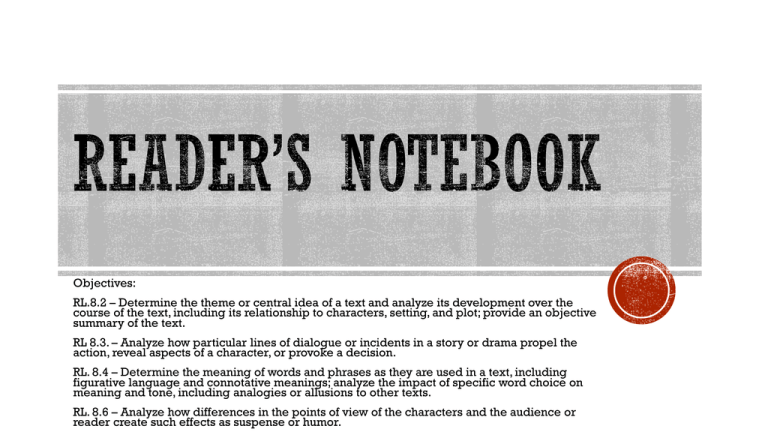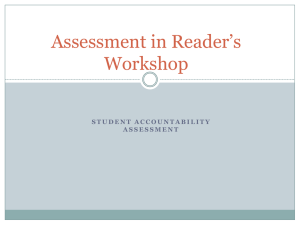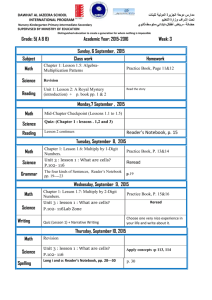Reader*s Notebook
advertisement

Objectives: RL.8.2 – Determine the theme or central idea of a text and analyze its development over the course of the text, including its relationship to characters, setting, and plot; provide an objective summary of the text. RL 8.3. – Analyze how particular lines of dialogue or incidents in a story or drama propel the action, reveal aspects of a character, or provoke a decision. RL. 8.4 – Determine the meaning of words and phrases as they are used in a text, including figurative language and connotative meanings; analyze the impact of specific word choice on meaning and tone, including analogies or allusions to other texts. RL. 8.6 – Analyze how differences in the points of view of the characters and the audience or reader create such effects as suspense or humor. Personalize the notebook! That means use words and pictures. Use the first page to identify and describe your self as a reader. THINK – What genre do I enjoy? Are there particular topics that I prefer to read? Is there a particular author that I enjoy? What books have I read that I would recommend to others? SHARE – What do you like about reading? What do you dislike? Where and when do you like to read? What type of characters would you like to read about? What do you not like to read? Readers set goals for themselves. A goal will be determined for each nine week period. Focus on setting a goal that is simply attainable. Determine what is realistic. After your goal is in mind, plan what you need to do to meet that goal. It's really no different from sports - if your goal is to win the game, you think about what steps you need to take to make that happen. You are only required to write a simple sentence or two and leave a blank space at the bottom. At the end of the nine weeks, you will go back and look through your reading logs to see if you met your goal. Then after thinking on it, write a reflection paragraph at the bottom of the page explaining whether or not you met your goal and why. Readers make plans for their lives. They think about the reading they are doing, but they also plan ahead for the books they want to read in the future. Readers constantly look for new books to read. Instead of trying to keep track of that list mentally, you can write those books down one a page in your reader's notebooks. Have a page for a list of books that you want to read so that if you have a friend that is reading an interesting book, you will be able to know the title since it will be written on this list. This is a quick way for you to note the book you are reading during the reading workshop in class or at home. This allows you to pace yourself so that you can achieve your goal and will prove to be a helpful planning tool. You will record the date, title, and genre. Select appropriate books based on your reading ability. You should be reading your book or writing your thoughts about your reading. You should be working silently so everyone around you can learn. Keep track of the books you have read on your reading log. For each entry, you must label the title of the novel and the date of the activity. Reader’s notebooks are interactive. You will be using various mediums to show mastery of skills (creative drawings, foldable items, and sticky notes). http://missklohnsclassroom.blogspot.com/2011/12/our-readers-notebooks.html http://www.julieballew.com/A_Literate_Life/Readers_Notebook.html List the Title on the top line Include the date on the right hand side Keep your pencil active while we review the short story. Think about information you may need to jot down or pictures you may want to draw. Focus on the main character. You may consider creating a character map. What do they think? What do they feel? What dialogue occurs between them and others? What is their relationship with other characters? How do they interpret the conflict they face? How or is it overcome? For this activity, you will be working with a partner to read “There Will Come Soft Rains” by Ray Bradbury. You will find this short story in your textbook on page 266. Make sure to do the following: Review your Critical Thinking Stems worksheet to provide you with ideas for taking notes on your Post-Its. Review your Suggestions for Reading Response Topics worksheet to help you respond in your notebook. Read and discuss the short story with your partner making sure to use the provided resources to guide you as you complete the activity. For this activity, you will be working with a partner to read “The Monkey’s Paw” by W.W. Jacobs. You will find this short story in your textbook on page 85. Make sure to do the following: Note this short story on your Reading Log. On your notes page, make sure to label the title and date. Review your Critical Thinking Stems worksheet to provide you with ideas for taking notes on your Post-Its. Review your Suggestions for Reading Response Topics worksheet to help you respond in your notebook. Read and discuss the short story with your partner making sure to use the provided resources to guide you as you complete the activity. After working in class with a partner and practicing activities in class, you should be ready to begin working independently in your Reader’s Notebook. This is your opportunity to ask any questions. You will be required to read your selected novel beginning on September 3,2013. Reader’s Notebooks will be due on September 6, 2013. You will be required to begin reading today in class and make your first entry in your journal. On December 2, you will be required to complete nightly readings and completing activities for the log. I will instruct you as to specific assignments or allow you to select activities from your Thinking Stems handout. Please recall Reader’s workshop Guidelines and follow those during classroom workshop times. Select appropriate books based on your reading ability. You should be reading your book or writing your thoughts about your reading. You should be working silently so everyone around you can learn. Keep track of the books you have read on your reading log. For each entry, you must label the title of the novel and the date of the activity. Reader’s notebooks are interactive. You will be using various mediums to show mastery of skills (creative drawings, foldable items, and sticky notes). Select three of the following activities from the Thinking stems handouts Asking Questions Visualizing/Sensory Images Setting Characters Plot Language Illustrator Open-ended Prompts






